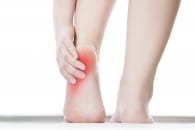What is the cause of heel pain?
Heel pain occurs in active children because the human foot was never meant to run on concrete, asphalt, gym floors, or pivot in soccer or basketball. Most heel pain in children is due to using the foot in a way it was never designed to be used. Heel pain is especially prevalent in children, since the bottom of the heel is not yet fully grown, so it contains a soft area of the bone called a growth plate, which is sensitive to repeated running and pounding on hard surfaces. This is why heel pain is common in children after they begin a sport that requires a lot of running or twisting on hard surfaces. When you examine your child’s heel and you pound on it gently and he winces, this is likely to be due to an overuse injury by pounding his heel too much on hard surfaces.
What to do about heel pain?
In our practice, we recommend heel cushions for all teens during sports. The foot was never designed to pound on gym floors and concrete. The heel bones are still growing and are sensitive. Put a silicone pad in your child’s shoe to cushion the sensitive, developing heel bones from pounding on hard surfaces. If the heel pain is severe, it would be best to take a week or two out of the activity you suspect is causing the pain. While your child is not playing the sport, be sure he wears a high quality running shoe that has a supportive heel, which will at least take some pressure off the heel during the times he does not wear the lower heel sports shoes, such as soccer shoes. If after a few weeks of rest and wearing a heel pad the painful heel has not completely subsided, certainly seek medical attention.
The heel of soccer shoes is purposely low to make the foot more useable for pivoting and kicking without injury. Be careful not to place a heel pad in your child’s soccer shoes without medical consultation, since if the pad is too high the lifting of the heel makes the ankle more prone to sprain.

